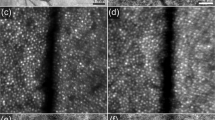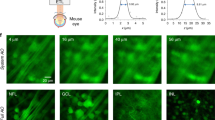Abstract
Super-resolution optical microscopy techniques have enabled the discovery and visualization of numerous phenomena in physics, chemistry and biology1,2,3. However, the highest resolution super-resolution techniques depend on nonlinear fluorescence phenomena and are thus inaccessible to the myriad applications that require reflective imaging4,5. One promising super-resolution technique is optical reassignment6, which so far has only shown potential for fluorescence imaging at low speeds. Here, we present novel advances in optical reassignment to adapt it for any scanning microscopy, including reflective imaging, and enable an order of magnitude faster image acquisition than previous optical reassignment techniques. We utilized these advances to implement optically reassigned scanning laser ophthalmoscopy, an in vivo super-resolution human retinal imaging device not reliant on confocal gating. Using this instrument, we achieved high-resolution imaging of living human retinal cone photoreceptor cells (determined by minimum foveal eccentricity) without adaptive optics or chemical dilation of the eye7.
This is a preview of subscription content, access via your institution
Access options
Access Nature and 54 other Nature Portfolio journals
Get Nature+, our best-value online-access subscription
$29.99 / 30 days
cancel any time
Subscribe to this journal
Receive 12 print issues and online access
$209.00 per year
only $17.42 per issue
Buy this article
- Purchase on Springer Link
- Instant access to full article PDF
Prices may be subject to local taxes which are calculated during checkout





Similar content being viewed by others
Code availability
The code used in this study is available at http://github.com/tdubose/ORSLO.
Data availability
The data that support the findings of this study are available from the corresponding author on reasonable request.
References
Betzig, E. et al. Imaging intracellular fluorescent proteins at nanometer resolution. Science 313, 1642 (2006).
Klar, T. A., Jakobs, S., Dyba, M., Egner, A. & Hell, S. W. Fluorescence microscopy with diffraction resolution barrier broken by stimulated emission. Proc. Natl Acad. Sci. USA 97, 8206–8210 (2000).
Gustafsson, M. G. L. Nonlinear structured-illumination microscopy: wide-field fluorescence imaging with theoretically unlimited resolution. Proc. Natl Acad. Sci. USA 102, 13081–13086 (2005).
Pawley, J. Handbook of Biological Confocal Microscopy (Springer Science & Business Media, Berlin, 2010).
Huang, D. et al. Optical coherence tomography. Science 254, 1178–1181 (1991).
Roth, S., Sheppard, C., Wicker, K. & Heintzmann, R. Optical photon reassignment microscopy (OPRA). Opt. Nanoscopy 2, 5 (2013).
Webb, R. H., Hughes, G. W. & Delori, F. C. Confocal scanning laser ophthalmoscope. Appl. Opt. 26, 1492–1499 (1987).
Roorda, A. & Williams, D. R. The arrangement of the three cone classes in the living human eye. Nature 397, 520–522 (1999).
DuBose, T. et al. Handheld adaptive optics scanning laser ophthalmoscope. Optica 5, 1027–1036 (2018).
Rossi, E. A. et al. Imaging individual neurons in the retinal ganglion cell layer of the living eye. Proc. Natl Acad. Sci. USA 114, 586–591 (2017).
Liu, Z., Kurokawa, K., Zhang, F., Lee, J. J. & Miller, D. T. Imaging and quantifying ganglion cells and other transparent neurons in the living human retina. Proc. Natl Acad. Sci. USA 114, 12803–12808 (2017).
Carroll, J., Neitz, M., Hofer, H., Neitz, J. & Williams, D. R. Functional photoreceptor loss revealed with adaptive optics: an alternate cause of color blindness. Proc. Natl Acad. Sci. USA 101, 8461–8466 (2004).
Duncan, J. L. et al. High-resolution imaging with adaptive optics in patients with inherited retinal degeneration. Invest. Ophthalmol. Vis. Sci. 48, 3283–3291 (2007).
Dubra, A. & Sulai, Y. Reflective afocal broadband adaptive optics scanning ophthalmoscope. Biomed. Opt. Express 2, 1757–1768 (2011).
Wilson, T. & Sheppard, C. Theory and Practice of Scanning Optical Microscopy (Academic Press, New York, 1984).
De Luca, G. M. R. et al. Re-scan confocal microscopy: scanning twice for better resolution. Biomed. Opt. Express 4, 2644–2656 (2013).
LaRocca, F. et al. In vivo cellular-resolution retinal imaging in infants and children using an ultracompact handheld probe. Nat. Photon. 10, 580–584 (2016).
Wilson, T. & Carlini, A. R. Size of the detector in confocal imaging systems. Opt. Lett. 12, 227–229 (1987).
Merino, D., Duncan, J. L., Tiruveedhula, P. & Roorda, A. Observation of cone and rod photoreceptors in normal subjects and patients using a new generation adaptive optics scanning laser ophthalmoscope. Biomed. Opt. Express 2, 2189–2201 (2011).
Zhang, Y., Poonja, S. & Roorda, A. MEMS-based adaptive optics scanning laser ophthalmoscopy. Opt. Lett. 31, 1268–1270 (2006).
Dubra, A. et al. Noninvasive imaging of the human rod photoreceptor mosaic using a confocal adaptive optics scanning ophthalmoscope. Biomed. Opt. Express 2, 1864–1876 (2011).
Zou, W., Qi, X. & Burns, S. A. Woofer-tweeter adaptive optics scanning laser ophthalmoscopic imaging based on Lagrange-multiplier damped least-squares algorithm. Biomed. Opt. Express 2, 1986–2004 (2011).
Sredar, N., Fagbemi, O. E. & Dubra, A. Sub-Airy confocal adaptive optics scanning ophthalmoscopy. Transl. Vis. Sci. Technol. 7, 17 (2018).
Merkle, C. W. et al. Visible light optical coherence microscopy of the brain with isotropic femtoliter resolution in vivo. Opt. Lett. 43, 198–201 (2018).
Sheppard, C. Super-resolution in confocal imaging. Optik 80, 53–54 (1988).
Sheppard, C. J. R., Mehta, S. B. & Heintzmann, R. Superresolution by image scanning microscopy using pixel reassignment. Opt. Lett. 38, 2889–2892 (2013).
Gregor, I. et al. Rapid nonlinear image scanning microscopy. Nat. Methods 14, 1087–1089 (2017).
Müller, C. B. & Enderlein, J. Image scanning microscopy. Phys. Rev. Lett. 104, 198101 (2010).
Winter, P. W. et al. Two-photon instant structured illumination microscopy improves the depth penetration of super-resolution imaging in thick scattering samples. Optica 1, 181–191 (2014).
York, A. G. et al. Instant super-resolution imaging in live cells and embryos via analog image processing. Nat. Methods 10, 1122–1126 (2013).
Zheng, W. et al. Adaptive optics improves multiphoton super-resolution imaging. Nat. Methods 14, 869–872 (2017).
Yellott, J. I. Spectral analysis of spatial sampling by photoreceptors: topological disorder prevents aliasing. Vis. Res. 22, 1205–1210 (1982).
Cooper, R. F., Langlo, C. S., Dubra, A. & Carroll, J. Automatic detection of modal spacing (Yellott’s ring) in adaptive optics scanning light ophthalmoscope images. Ophthalmol. Phys. Opt. 33, 540–549 (2013).
Curcio, C. A., Sloan, K. R., Kalina, R. E. & Hendrickson, A. E. Human photoreceptor topography. J. Comp. Neurol. 292, 497–523 (1990).
Shemonski, N. D. et al. Computational high-resolution optical imaging of the living human retina. Nat. Photon. 9, 440–443 (2015).
Kohl, S. et al. Mutations in the unfolded protein response regulator ATF6 cause the cone dysfunction disorder achromatopsia. Nat. Genet. 47, 757–765 (2015).
Hollyfield, J. G. et al. Oxidative damage–induced inflammation initiates age-related macular degeneration. Nat. Med. 14, 194–198 (2008).
Donnelly, W. J. & Roorda, A. Optimal pupil size in the human eye for axial resolution. J. Opt. Soc. Am. A 20, 2010–2015 (2003).
Laser Institute of America American National Standard for Safe Use of Lasers ANSI Z136.1–2007 (American National Standards Institute, 2007).
Thévenaz, P. & Unser, M. User-friendly semiautomated assembly of accurate image mosaics in microscopy. Microsc. Res. Tech. 70, 135–146 (2007).
Atchison, D. A. et al. Eye shape in emmetropia and myopia. Invest. Ophthalmol. Vis. Sci. 45, 3380–3386 (2004).
Chui, T. Y. P., Song, H. & Burns, S. A. Individual variations in human cone photoreceptor packing density: variations with refractive error. Invest. Ophthalmol. Vis. Sci. 49, 4679–4687 (2008).
Acknowledgements
The authors thank K. Zhou and R. Qian for assistance. This research was supported in part by a grant from the National Institutes of Health (R21-EY027086).
Author information
Authors and Affiliations
Contributions
F.L. and T.B.D. designed and constructed the optical system and drafted the manuscript. T.B.D. collected and analysed data. S.F. and J.A.I provided overall guidance to the project, reviewed and edited the manuscript, and obtained funding to support this research.
Corresponding author
Ethics declarations
Competing interests
The authors declare no competing interests.
Additional information
Publisher’s note: Springer Nature remains neutral with regard to jurisdictional claims in published maps and institutional affiliations.
Supplementary information
Supplementary Information
This file contains more information on the work and Supplementary Figures 1–7.
Rights and permissions
About this article
Cite this article
DuBose, T.B., LaRocca, F., Farsiu, S. et al. Super-resolution retinal imaging using optically reassigned scanning laser ophthalmoscopy. Nat. Photonics 13, 257–262 (2019). https://doi.org/10.1038/s41566-019-0369-7
Received:
Accepted:
Published:
Issue Date:
DOI: https://doi.org/10.1038/s41566-019-0369-7
This article is cited by
-
Nondestructive inspection of surface nanostructuring using label-free optical super-resolution imaging
Scientific Reports (2023)
-
Adaptive optics for high-resolution imaging
Nature Reviews Methods Primers (2021)



